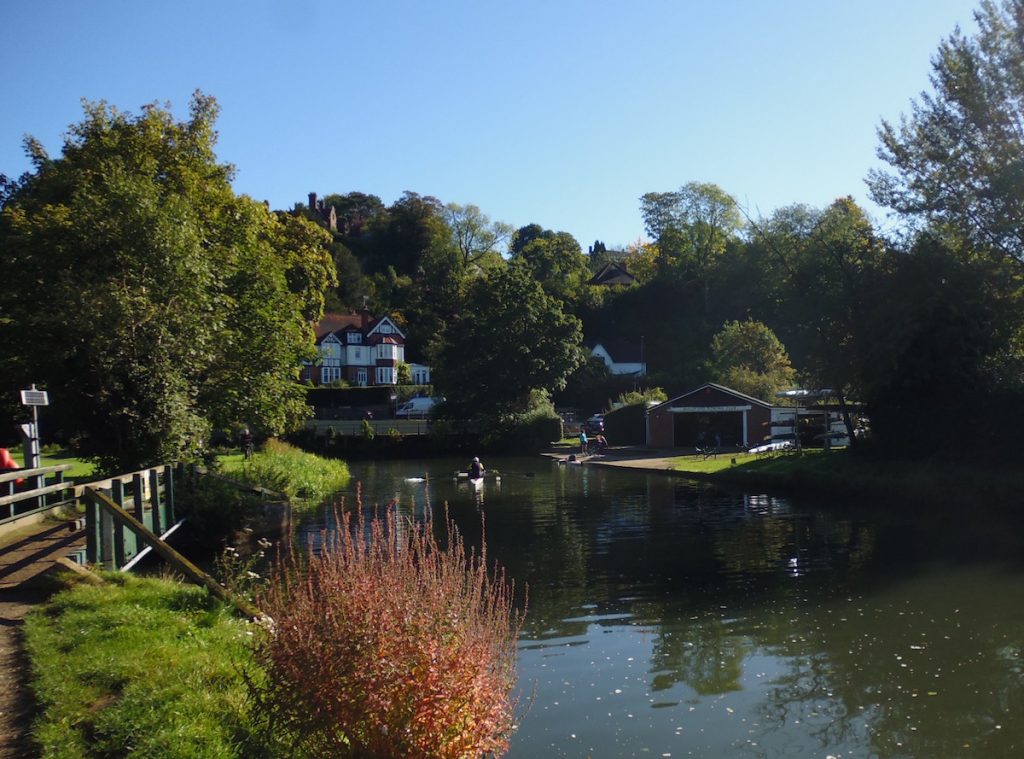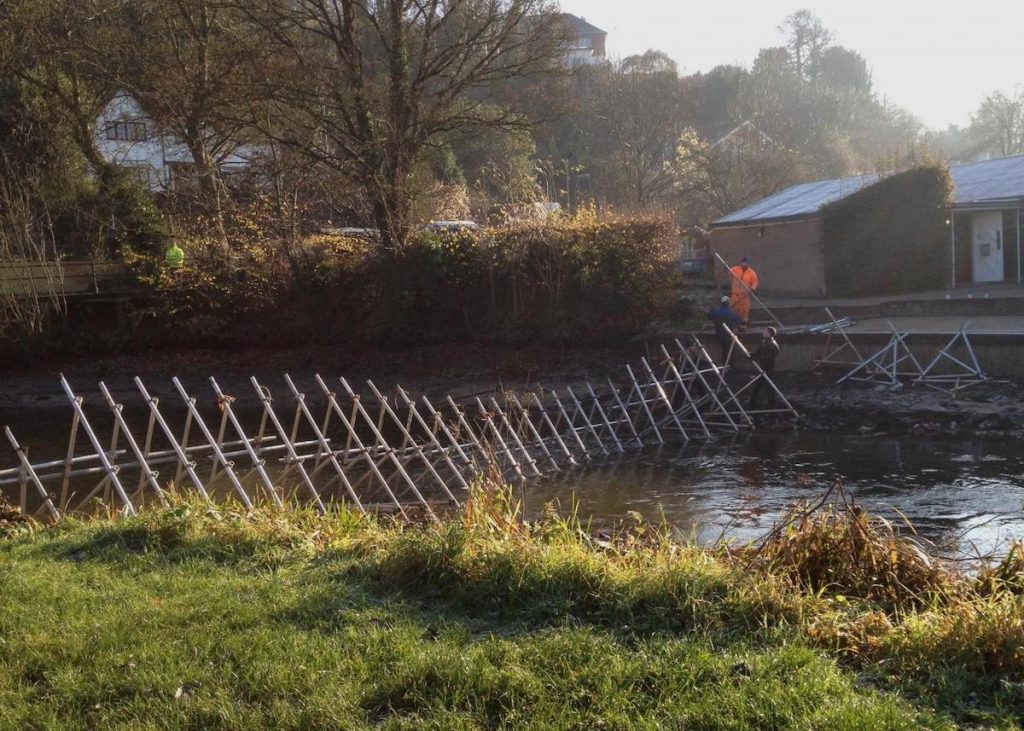 Abraham Lincoln
If given the truth, the people can be depended upon to meet any national crisis...
Abraham Lincoln
If given the truth, the people can be depended upon to meet any national crisis...
 Guildford news...
for Guildford people, brought to you by Guildford reporters - Guildford's own news service
Guildford news...
for Guildford people, brought to you by Guildford reporters - Guildford's own news service
Updated: Weir On The Wey, Plans Agreed to Repair Navigation Damage After Collapse
Published on: 4 Dec, 2019
Updated on: 5 Dec, 2019

The collapsed Tumbling Bay Weir with the breached temporary dam, formed of bags of ballast, put in place in the days following the collapse.
By Martin Giles
Plans to make the River Wey navigable through Guildford again, after the collapse of Tumbling Bay Weir, have been agreed by Guildford Borough Council, the National Trust and the Environment Agency.

Peter O’Connell
Details of “who-pays-for-what” have not been released but Peter O’Connell, director of Environment at GBC said those involved “have agreed how to address the immediate issue and how this is to be funded with partners”.
Immediate repairs to the weir (GBC also calls it “Town Mill Weir”) failed to return water levels to normal.
A GBC spokesperson said: “We placed about 100 bulk bags filled with inert material, covered with impervious heavy-duty sheeting to plug the gap. ”
This was always meant to be a temporary solution but worked only for 48 hours when a heavy peak in river flow topped the barrier and washed much of it away.
“We are now arranging for a different solution, a MURLAC Frame Dam System [not Portadam as previously reported] (see pictures below), to divert river flow and enable construction of a cofferdam where the failed weir used to be. This will be a temporary fix intended to restore the navigation while the permanent solution is designed.”
Mr O’Connell added: “Our priorities are public safety and making the river navigable again.
“The dams will raise water levels and limit damage to the river banks. Surrey County Council is also offering specialist expertise. We are continuing to work together with the National Trust to agree responsibilities and our priority remains to complete the remedial work, pending a permanent solution as soon as possible.”
The cofferdam is to be installed early in 2020 which will render the navigation usable.

The River Bed exposed by Millmead Lock after the dramatic drop in water level caused by the weir collapse.
The weir collapse left Guildford Rowing Club high and dry at Shalford Meadow. Some members had a lucky escape. Club secretary Paul Woowat said: “At the time of the collapse, luckily, there were no rowers, although a group of juniors had just come off the water.
“The fast current and quick drop in water levels would have had devastating effects on rowers and equipment if they had been on the water.
“Since the incident, we have been discussing options with the National Trust, Guildford Kayak Club, Guildford Sea Cadets and a whole range of organisations, including other rowing clubs on the Thames such as Walton RC and Weybridge RC, who may be able to give us a short-term home.
“Without exception, everyone has been incredibly helpful in supporting our club. We have forged strong bonds with these other river-users, especially those in Guildford itself.
“We now have a temporary rowing home at Dapdune Wharf, courtesy of the National Trust and Guildford Sea Cadets. This is not ideal for rowing because the river has sharp bends to navigate, but it’s been helpful in getting rowers back on the water. Our junior squad has also used Hawley Lake Sail Training Centre, in Hampshire.

Guildford Rowing Club has had its home on the Wey since 1880.
“Normally, we would be able to use stretches of the Thames but most of the river has been effectively closed for long periods due to near-flood conditions.
“We have a group of masters going to South Africa for a rowing camp and regatta in January. They were able to borrow an eight from Cygnet Rowing Club and row on the Tideway, the tidal part of the Thames used by the Oxford and Cambridge boat race.
“The National Trust has now updated us with the next stage of their plan, which is to build the Portadam just outside Guildford Rowing Club, forcing all the river flow through the sluice gates opposite the club. This will restore water levels but the new flow will make it dangerous and we have been advised not to use it.

The Portadam under construction today (December 4).
“We understand the MURLAC dam will be constructed on Wednesday, December 4, which will enable the Tumbling Bay Weir to be isolated using steel piling while repairs are done. The piling is to be installed from the middle to end of January.
“We hope the cofferdam will then be deconstructed and normal water levels restored to allow us to row normally.

The Portadam is positioned by Guildford Rowing Club just downstream from a sluice, visible on the left under the footbridge, which feeds the natural course of the river in Millmead.
“Members of our club, which was founded in 1880, have been working on development plans to build a new rowing club on the site. We have concerns that this event will delay plans and funds available.
“Using other locations incurs additional costs for the club and members themselves. We fear a reduction in membership numbers because those with less rowing experience may look elsewhere for exercise, sport and leisure time.”
Jacqui Mooney, National Trust general manager for the River Wey Navigations, said: “Our priority is to return the navigation back to being safe and usable as soon as possible. It is likely that the towpath will remain only partly accessible until the new permanent weir replacement is complete.”
Farncombe Boat House has not responded to our invitation to comment on the impact on their business.
Responses to Updated: Weir On The Wey, Plans Agreed to Repair Navigation Damage After Collapse
Leave a Comment Cancel replyPlease see our comments policy. All comments are moderated and may take time to appear.

See Dragon story: GBC’s Explanation of Major Land Sale Notice Error ‘Borders on Arrogant’ Says Councillor







Recent Articles
- Birdwatcher’s Diary No.302
- Diocese of Guildford Appoints New Registrar and Legal Advisor
- ‘One in Five’ Surrey Police Officers Seeking Another Job
- Insights: Lead from the Front on Values
- New Investment Will Help Surrey Fire and Rescue Service Improve Training Facilities
- Letter: Are the PCC Candidates Relying on Their Party Labels?
- Notice: Sing Barbershop – Every Tuesday
- Modernised Surrey Police Headquarters Will Require New Access Road
- Notice: Open Mic Night at the Guildford Institute – April 27
- ‘It Will Grow’ Says Councillor About Replacement Tree in Upper High Street


Recent Comments
- Ben Paton on ‘What Is Ofwat Doing?’ Asks a Customer
- Ben Paton on Insights: Lead from the Front on Values
- Jim Allen on Insights: Lead from the Front on Values
- David Smith on ‘It Will Grow’ Says Councillor About Replacement Tree in Upper High Street
- Penny Panman on ‘It Will Grow’ Says Councillor About Replacement Tree in Upper High Street
- John Dawson on ‘It Will Grow’ Says Councillor About Replacement Tree in Upper High Street
Search in Site
Media Gallery
Dragon Interview: Local Artist Leaves Her Mark At One of England’s Most Historic Buildings
January 21, 2023 / No Comment / Read MoreDragon Interview: Lib Dem Planning Chair: ‘Current Policy Doesn’t Work for Local People’
January 19, 2023 / No Comment / Read MoreA3 Tunnel in Guildford ‘Necessary’ for New Homes, Says Guildford’s MP
January 10, 2023 / No Comment / Read More‘Madness’ for London Road Scheme to Go Ahead Against ‘Huge Opposition’, Says SCC Leader
January 6, 2023 / No Comment / Read MoreCouncillor’s Son Starts Campaign for More Consultation on North Street Plan
December 30, 2022 / No Comment / Read MoreCounty Council Climbs Down Over London Road Works – Further ‘Engagement’ Period Announced
December 14, 2022 / No Comment / Read MoreDragon Interview: GBC Reaction to the Government’s Expected Decision to Relax Housing Targets
December 7, 2022 / No Comment / Read MoreHow Can Our Town Centre Businesses Recover? Watch the Shop Front Debate
May 18, 2020 / No Comment / Read More






Martin Elliott
December 4, 2019 at 10:07 am
If I remember correctly, a liaison group chaired by the Environment Agency with attendance by all councils and emergency responders was set-up for Surrey following the floods in 2014. This was to address the prevention, mitigation and response.
Apart from the drawn-out story of the Thames Diversion Channel funding, little has been heard in media. There were low key stories of a new response plan in Guildford for better deployment of ‘Portadams’ and sandbags in Guildford.
What surprises me is that I thought the first stage of any prevention plan would be to identify all the waterways infrastructure and those with ownership, responsibility or even duties to inspect and maintain.
Although this weir doesn’t seem to be critical to flood prevention, how many in Surrey with sluices, gates and spillways are critical, where ownership and management responsibilities are uncertain?